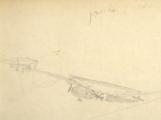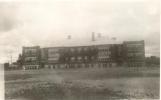1
During the decades of the 1920s and 1930s, the influence of the First World War had far reaching effects on the younger generation in Transcona. Children were reared with the knowledge that great sacrifices were made by their fathers, relatives, and neighbours during the war.3
"As I was growing up, I had occasion to be part of the tragedies of war; particularly when Uncle Emile (Poirier) would come home from work (at the Transcona Shops) and he would remove his shirt to wash up. I would ask him what those scars were on his back and he wouldn't say much except that he was wounded during the war. Years later, he told me that he was hit in the back by a piece of shrapnel. He walked five miles to get medical assistance where he collapsed from loss of blood. A trust relationship then developed. A bond was established between him and I. He was my hero!" (Paul Martin, In Awe With Life)5
Life in the railway town of Transcona became more difficult during the decade of the "Dirty Thirties" as depressed financial markets forced the railway to make massive layoffs, both on the railroad and at the Transcona Shops.7
Transcona families pulled together and made the most of what they had, though life was somewhat simple for the children growing up in the small railway town. Activities like biking, swimming in nearby gravel pits, and playing sports like soccer, baseball, and hockey occupied their time.8
The Phillips family in a canoe Ronnie Phillips seated in frontJuly 1936
Lake Malachi, North-Western Ontario

9
The vast majority of children received their education at Central School, the largest school in Transcona. Some attended other schools like South Side School, North Transcona or the Assumption Church School in the early years of their education. Some finished their education in Grade 8 while others were fortunate enough to remain in school until their graduation in Grade 11. Armed with their hopes for a bright future, it is unlikely that the high school students who graduated from Central School in June 1939 had any idea of what changes would come their way.10
Palma Hotel hockey team (ten males in hockey attire), 1931-32 season1931
Transcona, Manitoba, Canada

11
Upon completing Grade 8, many boys sought employment at the local railway shops, as part of the C.N.R. Apprenticeship program. In Transcona, the C.N.R. indentured young apprentices for a five-year period. At the Transcona Shops, Apprentices learned one of ten railway trades both in a classroom and in working on the job. Like the other railroaders, the C.N.R. Shop Whistle called the young apprentices to work.13
Tough times during the Depression meant that there were few opportunities for kids who were born, raised, and schooled in Transcona. Enrollment in the CNR Apprenticeship program was limited and most young men took whatever jobs they could find:"My first job was cleaning storm windows in Central School during the summer. I was tough carrying those big windows to the top floor: all for 25 cents per hour. I got a job with the C.N.R. (Canadian National Railway) reclaim plant sorting out scrap iron; after a few months I was laid off. It was now 1939." (Paul Martin, In Awe With Life)
14
Group photo of Canadian National Railway (CNR) Apprentices at the Transcona ShopsMay 1939
Transcona, Manitoba, Canada




